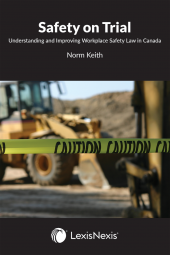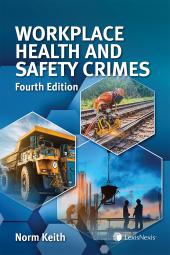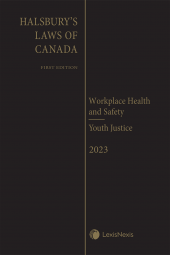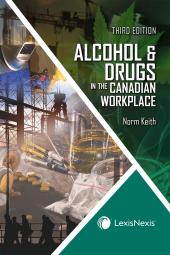It is with great pleasure that I highly recommend Safety on Trial, to everyone who has an interest in the health and safety of workers in the province of Ontario. As always, Norm brings forth clear concise information and explanations that will help guide us in understanding why we have the system that we do, why it works and more importantly why it doesn’t work.
Safety on Trial: Understanding and Improving Workplace Safety Law in Canada
One Year Subscription Only Terms
Subscribers receive the product(s) listed on the Order Form and any Updates made available during the annual subscription period. Shipping and handling fees are not included in the annual price.
Subscribers are advised of the number of Updates that were made to the particular publication the prior year. The number of Updates may vary due to developments in the law and other publishing issues, but subscribers may use this as a rough estimate of future shipments. Subscribers may call Customer Support at 800-833-9844 for additional information.
Subscribers may cancel this subscription by: calling Customer Support at 800-833-9844; emailing customer.support@lexisnexis.com; or returning the invoice marked 'CANCEL'.
If subscribers cancel within 30 days after the product is ordered or received and return the product at their expense, then they will receive a full credit of the price for the annual subscription.
If subscribers cancel between 31 and 60 days after the invoice date and return the product at their expense, then they will receive a 5/6th credit of the price for the annual subscription. No credit will be given for cancellations more than 60 days after the invoice date. To receive any credit, subscriber must return all product(s) shipped during the year at their expense within the applicable cancellation period listed above.
Détails des produits
“A must read for any safety professional! Safety on Trial brings an accurate and clear account of the attitudes and obstacles encountered by employers, supervisors, and workers that prevent the internal responsibility system from truly functioning properly to make a significant impact on safety in the workplace.” – Halyna Pilkiw, BASc, CRSP, Health and Safety Manager, Hardrock Group of Companies
"Norm Keith has turned more than four decades of experience at the front line of health and safety law into a focussed text that should be required reading for every single health and safety stakeholder – particularly legislators. He has prepared an easy-to-understand historical overview of the health and safety systems in place across Canada today, while also developing a clear roadmap for changes in our approach to health and safety, which if adopted, would most certainly improve on the overarching goal of accident and injury prevention.” – Andrew Murray, partner, Lerners LLP
“This new book … is a “must read” for every safety professional, enforcement inspector, Minister of Labour, and business leader that values people and their right to a safe and productive workplace. Norm goes beyond the usual legal precedence and integrates the leading principle that accident prevention and workplace injury reduction is a business and government imperative... His detailed and easy to understand descriptions of the OHS legal framework and current enforcement law ... work together and create the safest workplaces possible by learning from our past and succeeding in the future.” – Peter Sturm, EMBA, BA, CRSP, CHSC, STRUM Consulting Inc.
Safety on Trial: Understanding and Improving Workplace Safety Law in Canada is the most recent text by Norm Keith, Canada’s leading occupational health and safety (OHS) lawyer. It covers the origins of modern Canadian health and safety legislation, the evolution of the internal responsibility system, and regulatory models of workplace safety.
The book addresses the modern approach to the enforcement of health and safety legislation across Canada by regulatory and criminal prosecution. It explores the panoply of legal issues that OHS professionals and their legal advisors must consider and deal with on a regular basis. It also provides legislative and practical suggestions for improving workplace safety for Canadian workers.
Topics Covered
- The origins and legislative framework of Canadian OHS laws
- Workplace safety policy models
- Criminalizing workplace stakeholders, corporations and individuals
- The OHS trial process, from the decision to prosecute, to acquittals, convictions and appeals
- Prosecutions under the Westray Bill
- Leadership in workplace safety
- Recommendations for OHS regulators and employers to improve workplace safety
Who Should Read This Book
- Employment and OHS lawyers – to advise their clients on the latest developments in OHS law
- In-house counsel – to guide to their employers on strategies to comply with their OHS duties and avoid liability under the Criminal Code
- Unions and Union representatives – to understand their members rights under OHS legislation
- Human Resources managers & OHS managers and officers – to formulate a legally-compliant and robust OHS program in the workplace
- Environment, Health & Safety professionals, including Chief Safety officers, Chief Risk/Compliance officers, EHS directors and JHSC committees – to ensure companies comply with OHS legal duties
- OHS professors and students – to help with research on OHS law
Avis des clients
Norm provides a detailed review on the legal landscape in Canada and some key suggestions on what industries need to do to avoid legal risks… his book offers proactive suggestions for unions, regulators and employers on progressive ways for workplace parties to protect and improve the health and safety of all workers.
The book does an incredible job in highlighting the shared responsibility among all workplace stakeholders, including employers, employees, safety regulators … emphasizing the crucial role each party plays in ensuring a safe work environment. Norm also delves into the historical origins, purposes, and policy models of the workplace safety legal framework … A must-read for safety professionals aiming to drive positive change in the industry.
Table des matières
PART I – CANADIAN OCCUPATIONAL HEALTH AND SAFETY LEGAL FRAMEWORK
Chapter 1: Workplace Safety Matters to Everyone
Chapter 2: Workplace Safety Policy Models
Chapter 3: Origins of Canadian Occupational Health and Safety Law
Chapter 4: The Purpose of Occupational Health and Safety Laws
Chapter 5: External Responsibility System
Chapter 6: The Legislative Framework of Occupational Health and Safety Laws
Chapter 7: Regulatory and Criminal Law Distinctions
Chapter 8: Criminalizing Workplace Stakeholders
Chapter 9: Safety by the Numbers
Chapter 10: Improving Workplace Safety in Canada
PART II – OCCUPATIONAL HEALTH AND SAFETY LAW FRAMEWORK AND ENFORCEMENT
Chapter 11: Which Government Has Enforcement Authority
Chapter 12: The Decision to Prosecute Under Occupational Health and Safety Laws
Chapter 13: Understanding the Occupational Health and Safety Charge
Chapter 14: Providing Disclosure to the Defence
Chapter 15: What the Prosecution Has to Prove
Chapter 16: Who Presides at an Occupational Health and Safety Trial
Chapter 17: Occupational Health and Safety Investigator’s Misconduct
Chapter 18: Prosecutorial Misconduct
Chapter 19: The Negligent and Delinquent Worker
Chapter 20: Has The Prosecutor Proven Its Case
Chapter 21: The First Branch of The Due Diligence Defence
Chapter 22: The Second Branch of The Due Diligence Defence
Chapter 23: Acquittals and Convictions
Chapter 24: Punishing The Corporate Offender
Chapter 25: Punishing The Individual Offender
Chapter 26: Appealing The Trial Decision
Chapter 27: Prosecutions Under the Westray Bill
Chapter 28: What To Consider Before Pleading Guilty
PART III – IMPROVING WORKPLACE SAFETY IN CANADA
Chapter 29: Leadership In Workplace Safety
Chapter 30: Limits of Occupational Health and Safety Law Enforcement
Chapter 31: Revisiting The Internal Responsibility System
Chapter 32: National Workplace Safety Standards Code
Chapter 33: Introduction to Deferred Prosecution Agreements
Chapter 34: Recommendations For Occupational Health and Safety Regulators
Chapter 35: Recommendations For Employers
Chapter 36: Final Thoughts For Improving Workplace Safety
 Lexis Nexis
Lexis Nexis 


